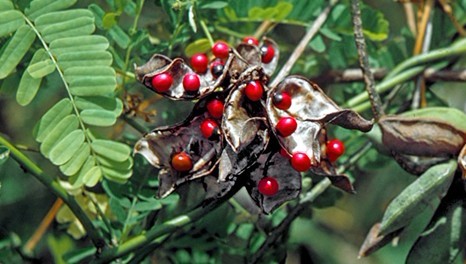Abrus precatorius, known commonly as Jequirity, Crab's Eye, Rosary Pea, John Crow Bead, Precatory bean, Indian Licorice, Akar Saga, Giddee Giddee or Jumbie Bead in Trinidad & Tobago, is a slender, perennial climber that twines around trees, shrubs, and hedges. It is a legume with long, pinnate-leafleted leaves. It is also known as Gunja in Sanskrit and some Indian languages and Ratti in Hindi.
Abrus precatorius, called kudri mani in Tamil and guru ginja in Telugu, has been used in Siddha medicine for centuries. The Tamil Siddhars knew about the toxic effects in plants and suggested various methods which is called "suththi seythal" or purification.The plant is best known for its seeds, which are used as beads and in percussion instruments, and which are toxic due to the presence of abrin.
The seeds of Abrus precatorius are very consistent in weight. Formerly Indians used these seeds to weigh gold using a measure called a Ratti, where 8 Ratti = 1 Masha; 12 Masha = 1 Tola.
| Catalog | Product Name | CAS Number | Manual |
|---|---|---|---|
| n/a | n/a | 526-31-8 | n/a |
| CFN97256 | 1H-Indole-3-carboxylic acid | 771-50-6 | n/a |
| CFN97132 | Uracil | 66-22-8 | n/a |
| CFN99962 | Formononetin | 485-72-3 | |
| CFN99916 | Beta-Sitosterol | 83-46-5 | |
| CFN90634 | Hypaphorine | 487-58-1 | n/a |
A unique collection of 21 natural compounds from Coptis chinensis Franch.
A unique collection of 27 natural compounds from Saposhnikovia divaricata
A unique collection of 21 natural compounds from Garcinia hamburgy Hook. f.
A unique collection of 23 natural compounds from Astragalus membranaceus ( Fish ) Bunge var. Mongholicus (Bunge) Hsiao





